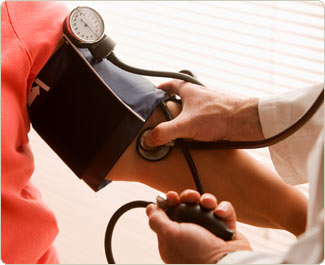 Blood pressure and heart rate go hand in hand (or arm in cuff) in most people’s minds. After all, these two “vital signs” are measured together at the doctor’s office.
Blood pressure and heart rate go hand in hand (or arm in cuff) in most people’s minds. After all, these two “vital signs” are measured together at the doctor’s office.
But the two measure distinct factors related to your heart health. Blood pressure is the force of blood flowing against the walls of your arteries, while heart rate (or pulse) is the number of times your heart beats every minute. Below, Cleveland Clinic cardiologist Michael Faulx, MD, explains some key differences — and busts some common myths along the way.
1. Blood pressure and heart rate are always linked
False: It is true that blood pressure and heart rate often rise and fall together, Dr. Faulx says. When you face danger, for example, your blood pressure and pulse may both jump upward at the same time.
However, if your heart rate rises, that doesn’t automatically mean your blood pressure will rise — or vice versa. “When the two are disconnected, you may be looking at a specific problem,” Dr. Faulx says. “For example, if your blood pressure is consistently high but your heart rate stays in your typical range, we may need to look at treatment specifically for high blood pressure.”
2. There’s one “normal” for blood pressure and heart rate
False: There are guidelines, but what’s normal varies from person to person.
Optimal blood pressure is typically defined as 120 mm Hg systolic (the top number, which is the pressure as your heart beats) over 80 mm Hg diastolic (the bottom number, which is the pressure as your heart relaxes). For your resting heart rate, the target is between 60 and 100 beats per minute. But keep in mind, “Both heart rate and blood pressure are a customized fit,” Dr. Faulx says. “You need to work with your doctor to establish a baseline that’s normal for you.”
3. Going “low” always indicates a problem
False: What’s healthy for one person may indicate danger for another. For example, a young, fit person may have a resting heart rate in the 50s or, in some cases, even the 40s. “It can actually be a badge, a sign of being in really good shape,” Dr. Faulx notes.
Low blood pressure can be a bit trickier, especially in older patients and those with heart disease. If you’re in danger from low blood pressure, your body will tell you. “It’s really about how you feel,” Dr. Faulx says. “Are you dragging and feeling weak? The numbers on their own don’t tell the story; it’s the numbers paired with how you are feeling and what symptoms you may have.”
4. High blood pressure or heart rate is more likely to be dangerous
True: Again, “normal” varies. But Dr. Faulx says there is enough clinical evidence to suggest that when blood pressure is even a little over your typical average over time, the risk for heart disease and stroke go up. The physical effects of high blood pressure take their toll on your blood vessels.
Elevated heart rate can be a sign of danger, too, but the cause-effect relationship is not so clear. “Studies show that people who run a faster heart rate are more likely to have cardiac problems and premature cardiac death,” Dr. Faulx says. “But we’re not sure whether that is the cause of the problem or just a sign of what’s going on.”
5. When you measure matters
True: To measure your resting heart rate and blood pressure, pick a time when you’re feeling relaxed, Dr. Faulx advises. Randomly sampling both measures throughout the day can also help you reach an average. Don’t take your readings right after exercising — unless you’re trying to establish a baseline for “active” blood pressure and heart rate.
Which measure is more important depends on your health, too. For patients with atrial fibrillation, heart rate might be more important to watch, but many other heart diseases depend more on blood pressure. To be safe, measure both.
“Almost all automated kits you buy at a drugstore are going to give you blood pressure and pulse on one readout,” Dr. Faulx says. “It’s convenient — and there’s really no reason not to stay on top of both.”
— The Beating Edge Team

